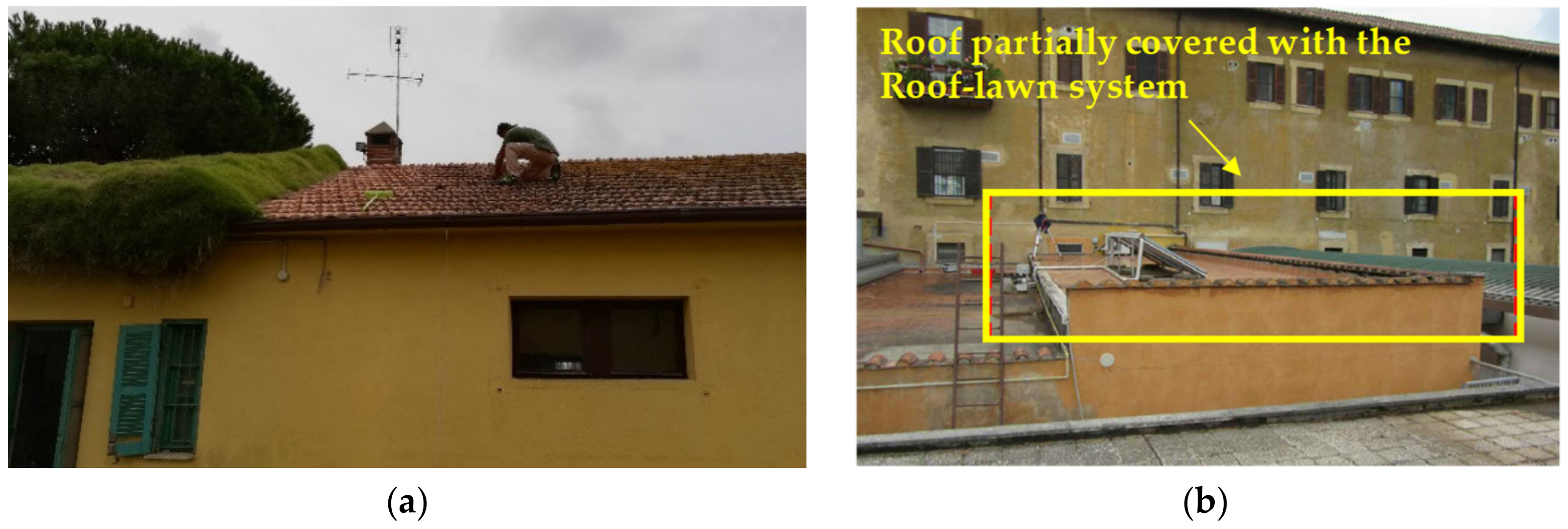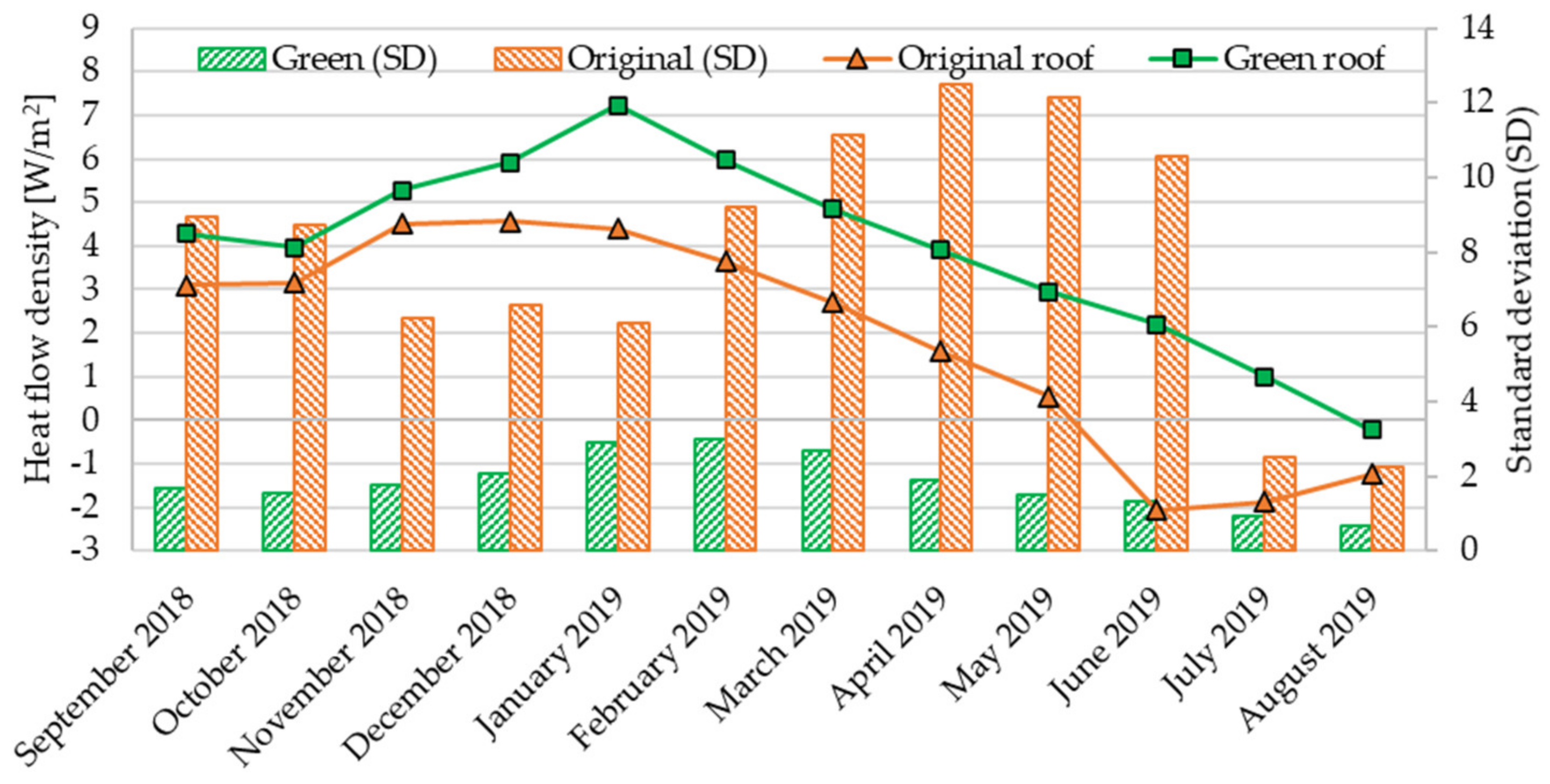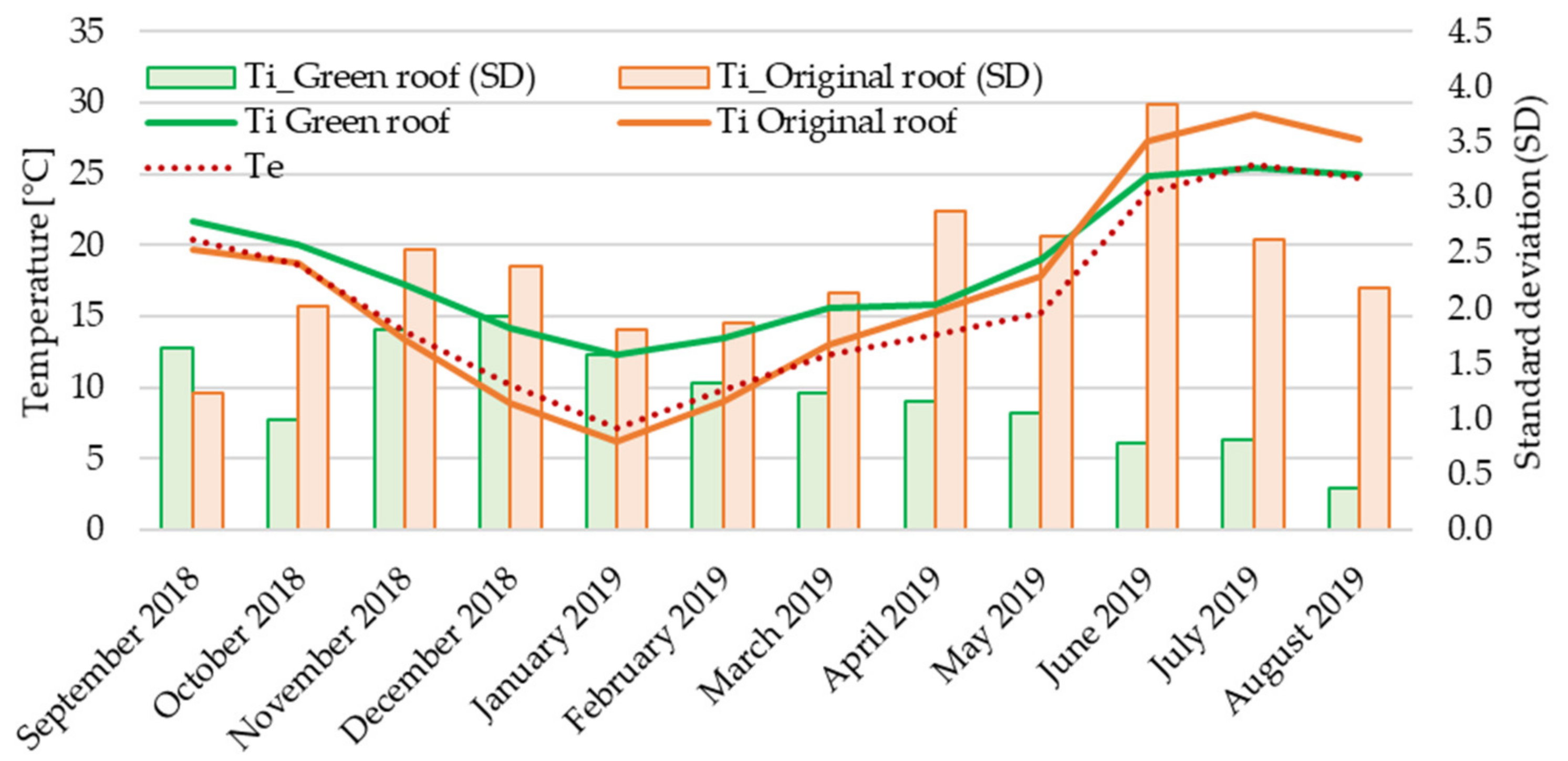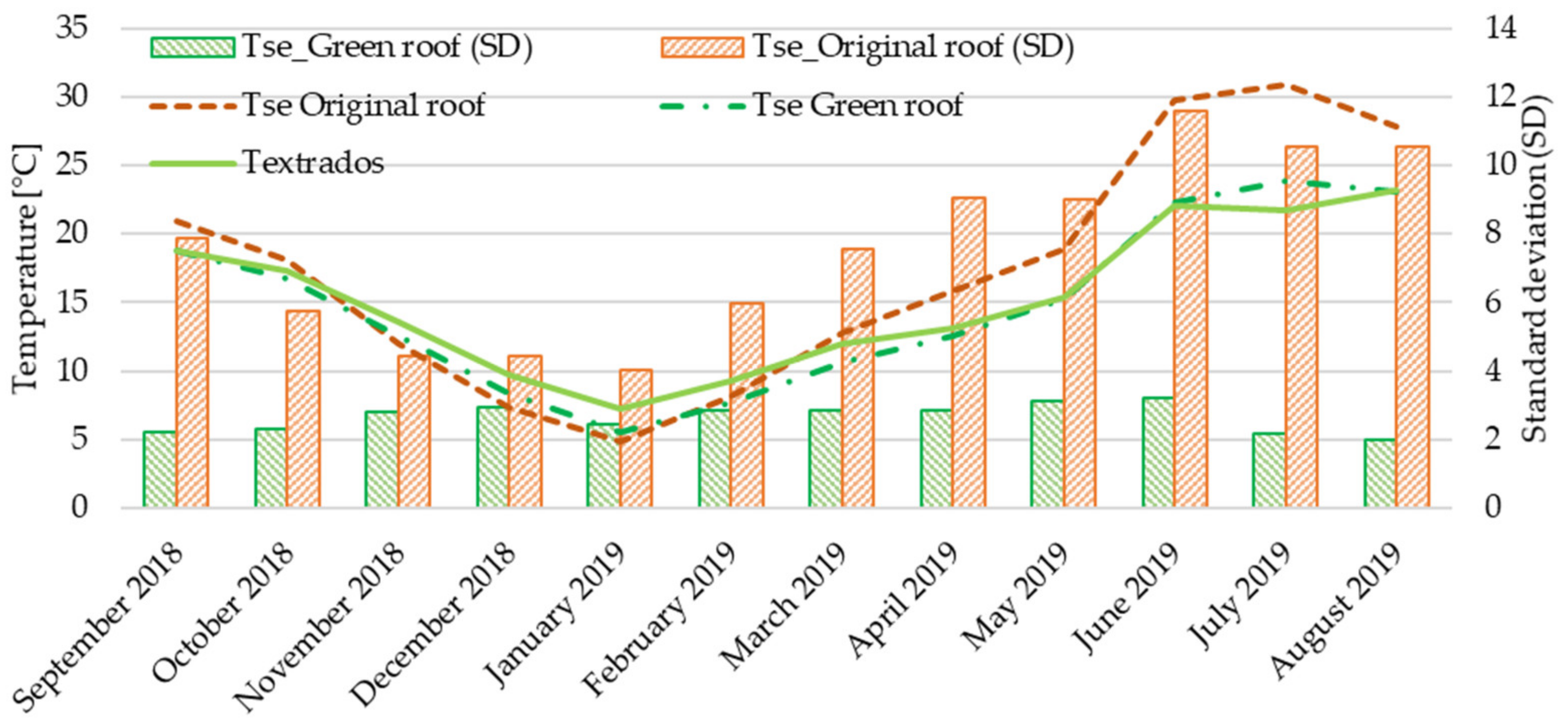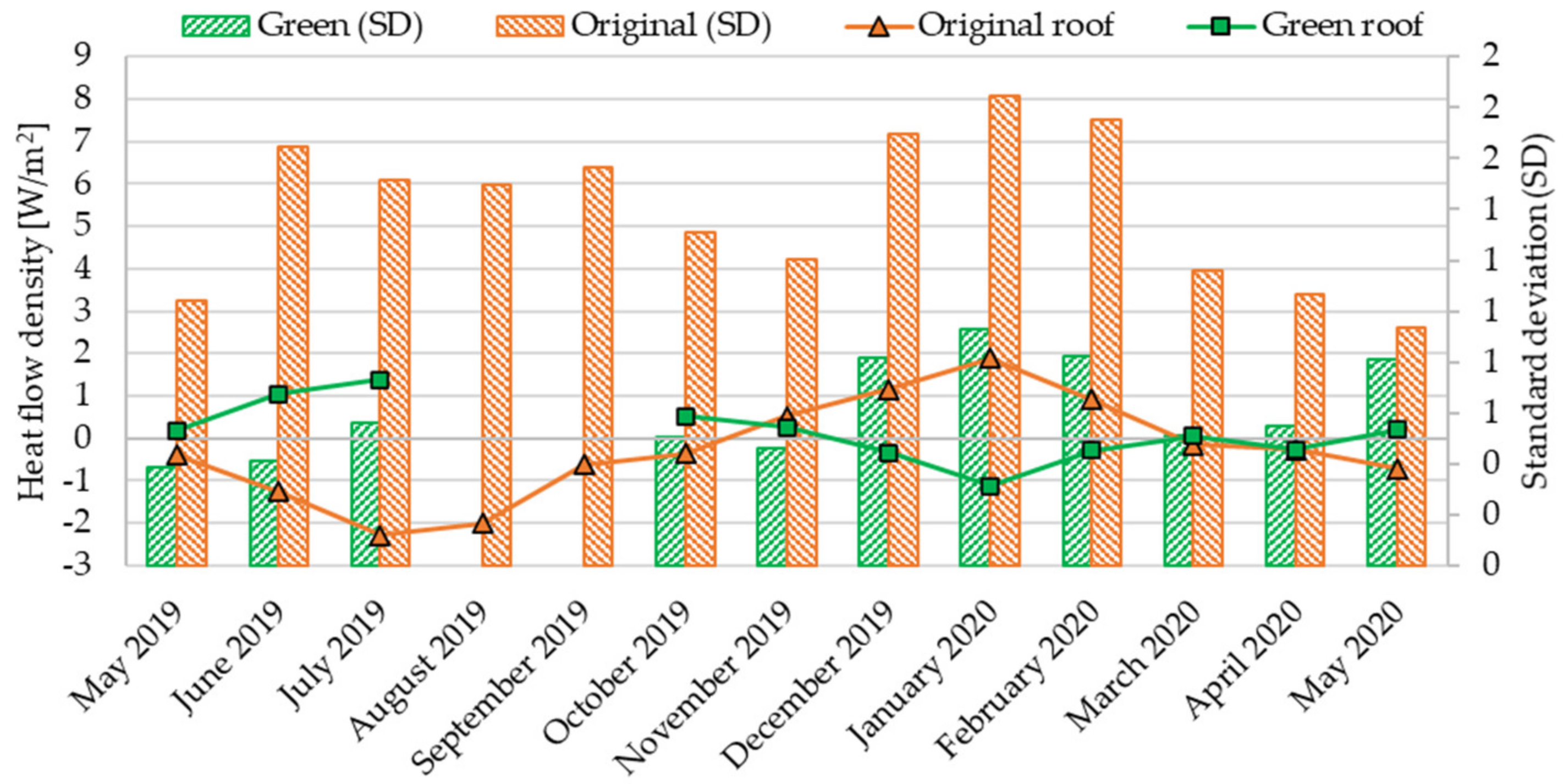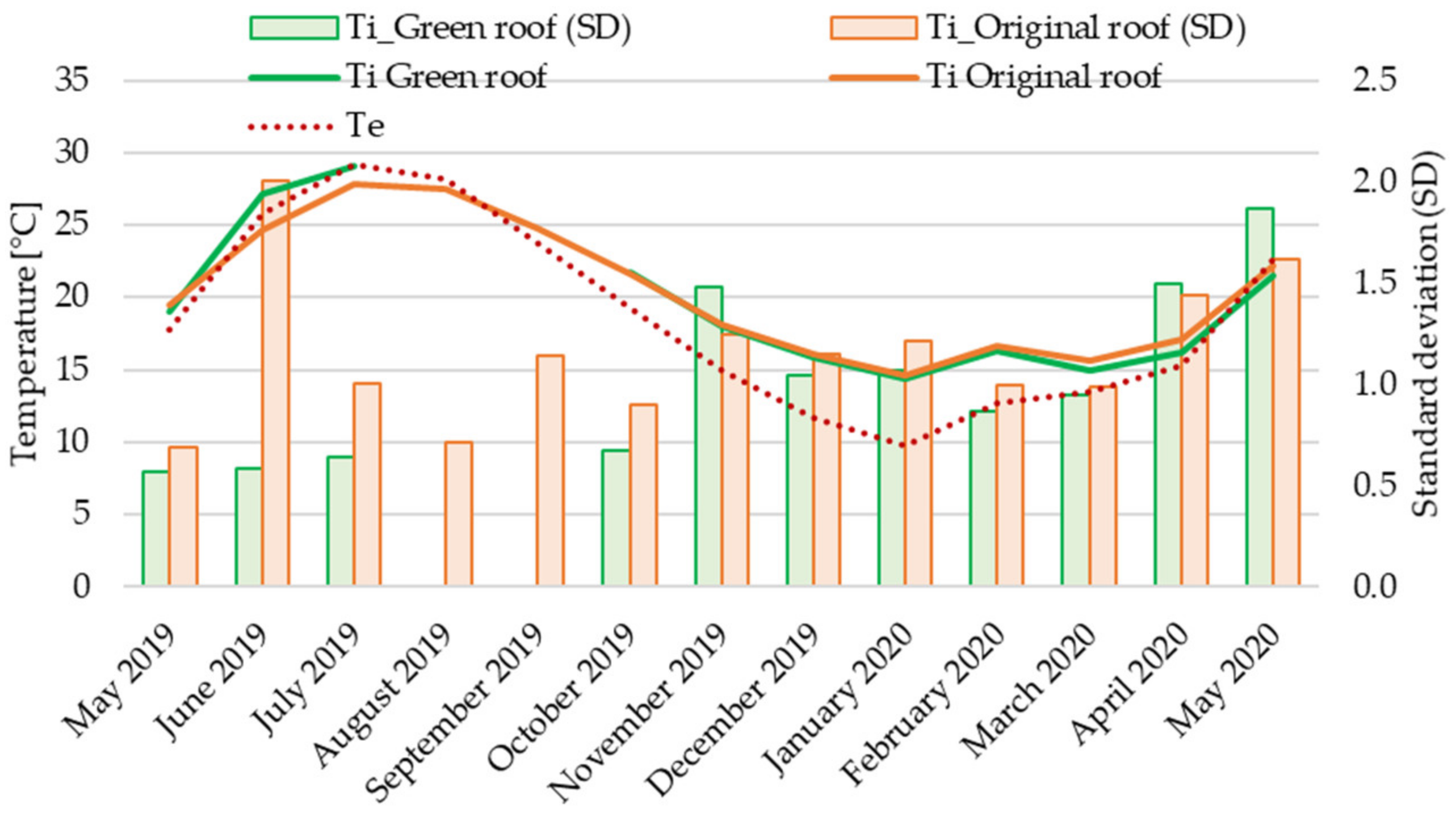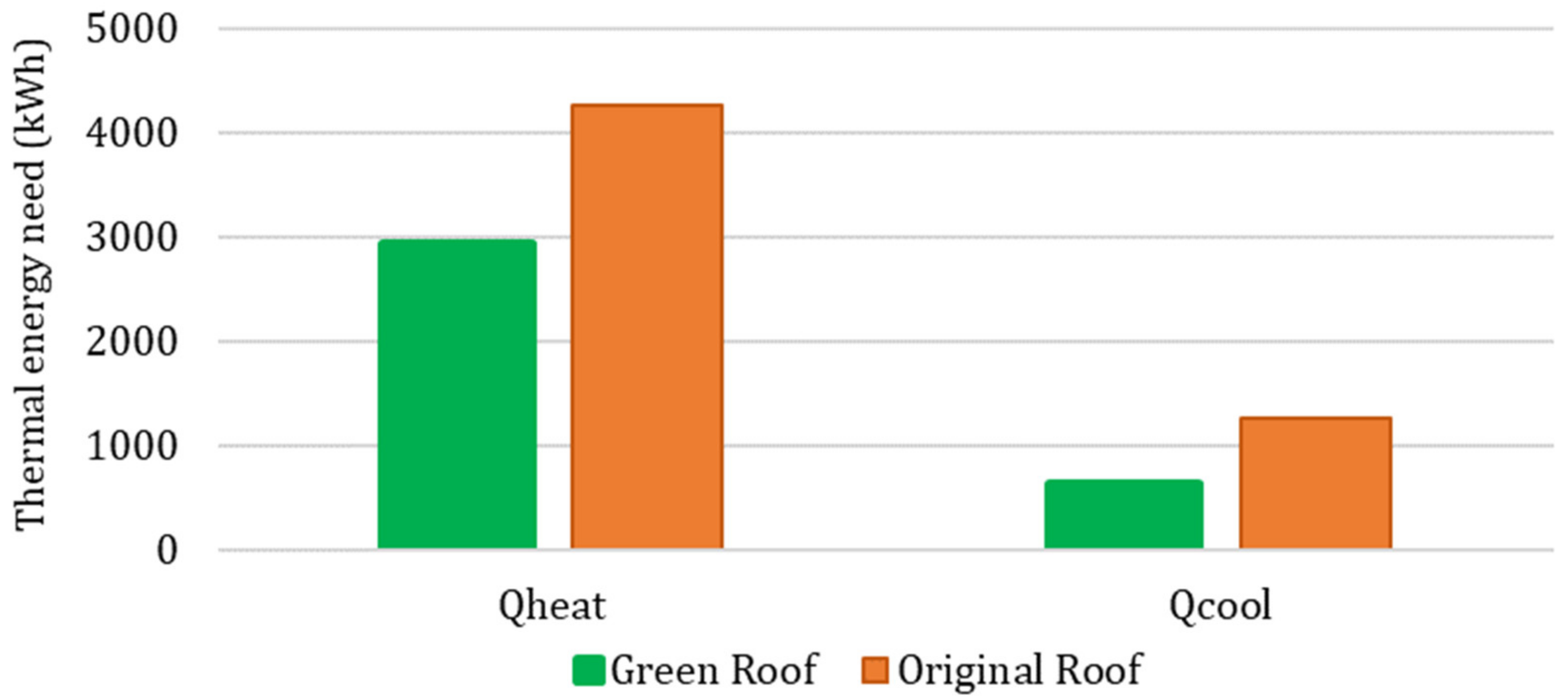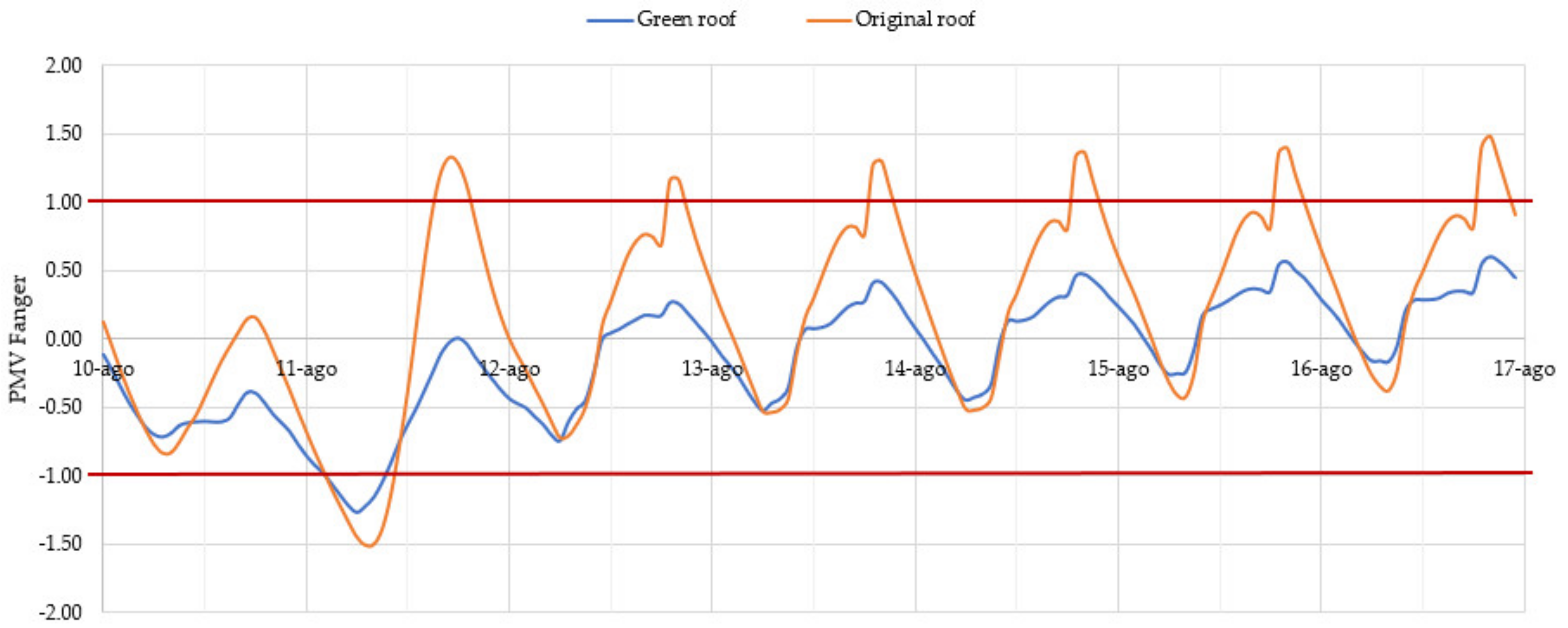3.1. Case 1—Experimental Investigation
The experimental results are reported in this section. One-year monitoring is characterized by a very large amount of data. It is worthy to observe that, over a whole year, recording heat fluxes and temperatures every 10 min does not allow a clear graphical representation of the sinusoidal trends for readers. Thus, in order to provide a clear view of the yearly behaviors of the investigated green roofs, the results are here presented in terms of average data and standard deviations (SDs). It is well-known that SD is a measure of the dispersion of a set of values. A low SD indicates that the values tend to be close to the mean of the set. Conversely, a high SD indicates that the values are spread over a wider range. Thus, using average data and SDs, it is possible to make a simplified direct comparison between the thermal behavior of the green roof and the original one, thus observing the fluctuations of the single quantities on a monthly basis. Starting from September 2018 to August 2019, it is possible to analyze the performance of the green roof considering diverse weather conditions.
Figure 3 shows the average values of the heat flow densities and their SDs. The average monthly heat flow densities are represented in the graph by continuous lines on the main axis: the green curve is relative to the green roof (indicated in the legend with “Green roof”), while the orange one refers to the original roof (indicated with “Original roof”).
In the secondary axis, the monthly SD of the heat flow are represented: the green columns are relative to the green roof (indicated by “Green (SD)”), while the orange ones are relative to the original roof (“Original (SD)”).
The analysis of the heat flow densities reveals low average values for the original roof, but it is worthy to note that it is characterized by SD values always higher than those related to the green roof. Therefore, when compared with the original one, a stable thermal performance of the green roof can be observed. Taking into consideration December 2018 (representative of the winter season), the external air temperatures ranged between 3.83 °C and 14.16 °C. Throughout this month, the highest heat flux value was about 14 W/m2, much lower than that recorded for the original roof (with a heat flux higher than 18 W/m2). The low thermal inertia of the original roof revealed a strong heat fluxes oscillation, also with negative values. The greater inertial effects of the roof-lawn system can be observed even more clearly during the middle season (from March 2019 to April 2019). Taking into consideration April 2019, the external air temperatures ranged between 5.53 °C and 26.23 °C. For the green roof, a maximum heat flux of about 10.7 W/m2 was recorded. On the other hand, a maximum heat flow value of about 19.1 W/m2 was registered for the original roof.
During the summer season, considering June 2019 as a representative month, the external air temperatures varied between 16.0 °C and 33.4 °C. In this month, for the green roof, the highest heat flux was about 6 W/m
2. Conversely, for the original roof, the highest heat flow was about 15 W/m
2. In order to provide an overview,
Table 3 summarizes the average, the minimum and the maximum heat fluxes registered during each month.
The average outdoor air temperatures, the average indoor air temperatures and their SD are reported in
Figure 4.
The monthly average indoor air temperatures are represented in the graph by continuous lines on the main axis: the green curve is relative to the green roof (indicated in the legend with “Ti Green roof”) while the orange one refers to the original roof (indicated with “Ti Original roof”). On the main axis, the red dashed curve of the outside air temperature (indicated with “Te”) is also represented.
The secondary axis shows the monthly SDs of the monthly indoor air temperature: the green columns refer to the green roof (indicated by “Ti_Green (SD)”), while the orange ones refer to the original roof (“Ti_Original (SD)”).
The constant thermal behavior of the green roof can be deduced also by observing the average internal air temperatures (
Figure 4). From September 2018 to May 2019, they are always characterized by higher values when compared with the average indoor air temperatures of the original roof. On the contrary, during June, July and August 2019 the indoor air temperatures are lower than those registered for the original roof, with subsequent advantages in terms of indoor thermal comfort. Furthermore, in this case, SDs calculated for the original roof are greater than those computed for the roof equipped with the roof-lawn system. The behavior of the green roof is related both to the additional thermal resistance caused by the additional layer represented by the roof-lawn system and to the increased thermal inertia. Indeed, considering December 2018, the green roof caused an average indoor air temperature of 14.14 °C. Conversely, for the original roof, indoor air temperature showed an average value of 8.95 °C. During the middle season (April and May 2019) the average indoor air temperatures are similar, but it is possible to observe better performance with the roof-lawn system; during April 2019, a minimum internal air temperature of 13.91 °C caused by the green roof, and a minimum value of 9.52 °C caused by the original roof were obtained. Moreover, for the indoor air temperatures, aiming at providing an outline,
Table 4 recaps the average, the minimum and the maximum values registered during each month.
Finally, the average external surface temperatures and their SDs are shown in
Figure 5, along with the extrados’ average temperatures measured under the roof-lawn system. The monthly average temperatures of the external surface are represented in the graph by dashed curves on the main axis: the green curve is relative to the green roof (indicated in the legend with “
Tse Green roof”), while the brown one refers to the original roof (indicated with “
Tse Original roof”). On the main axis, the green continuous curve of the extrados’ temperature is also shown (indicated by “
Texstrados”).
The secondary axis shows the monthly SDs of the external surface temperatures: the green columns are related to the green roof (denoted by “Tse_Green (SD)”), while the orange ones are related to the original roof (“Tse_Original (SD)”).
The outer side of the investigated roofs is completely different in terms of materials and heat transfer mechanisms. The effect of the thermophysical features of the employed materials played an essential role. The tiles on the original roof absorbed solar radiation because of their high absorptance coefficient. For the green roof, this did not happen because of the evapotranspiration phenomena of the greenery. Moving from the colder months to the warmer ones, it is possible to observe much higher average external surface temperatures in the case of the original roof. Analyzing the summarizing data listed in
Table 5, the original roof reached about 55 °C, while the external temperatures of the roof-lawn system reached values which do not exceed about 30 °C.
The recorded data during winter allowed the calculation of the
U-value of the roofs. For the green roof, a
U-value of 1.361 W/(m
2K) was found and, for the original one, a value of 3.021 W/(m
2K) was obtained. Thus, making a comparison between the roofs, a percentage difference in terms of thermal transmittance of about −55% can be pointed out. Moreover, applying Equation (3), the thermal conductance of the roofs was computed, finding 1.168 W/m
2K for the green roof and 2.811 W/m
2K for the original one, with a resulting percentage difference of −58.45%. The measurement of the green roof extrados’ temperature and the external surface temperature allowed a preliminary calculation of the roof-lawn thermal conductance, which was equal to 4.487 W/m
2K. All these results are summarized in
Table 6.
3.2. Case 2—Experimental Investigation
The experimental results of Case 2 are reported in this section. Again, the results of a one-year monitoring are presented here in terms of average data and SDs. Therefore, it is possible to make a direct comparison between the green roof and the original roof over time, also observing the fluctuations of the individual quantities on a monthly basis. From May 2019 to May 2020, it is possible to comprehend the thermal behavior of the green roof under different weather conditions.
It is necessary to specify that this monitoring has some missing data caused by the malfunction of the installed sensors.
Figure 6 shows the average values of the heat flow densities and their SDs.
The average monthly heat flow densities are represented in the graph by continuous lines on the main axis: the green curve is relative to the green roof (indicated in the legend with “Green roof”), while the orange one refers to the original roof (indicated with “Original roof”).
In the secondary axis, the monthly SDs of the heat flow are represented: the green columns are relative to the green roof (indicated by “Green (SD)”), while the orange columns are relative to the original roof (“Original (SD)”).
The analysis of the heat flow densities reveals low average values for the original roof, but it is important to note that it is characterized by SD values always higher than those related to the green roof.
The greater inertial effects of the roof-lawn system can be observed even more clearly during the middle season. Taking into consideration May 2019, the external air temperatures ranged between 12.58 °C and 25.77 °C. For the green roof, a maximum heat flux of about 1.33 W/m2 was recorded. On the other hand, a maximum heat flow value of about 2.88 W/m2 was registered for the original roof. Taking into consideration May 2020, the external air temperatures ranged between 13.82 °C and 34.53 °C. For the green roof, a maximum heat flux of about 2.66 W/m2 was recorded. On the other hand, a maximum heat flow value of about 3.06 W/m2 was registered for the original roof.
During summer, considering June 2019 as a representative month, the external air temperatures ranged from 14.06 °C to 37.99 °C. In this month, for the green roof, the highest heat flux was about 2.38 W/m2. Conversely, for the original roof, the highest heat flow was about 4.0 W/m2.
In order to provide an overview,
Table 7 summarizes the average, the minimum and the maximum heat fluxes registered during each month.
Comparing the green and the original roofs, a more stable thermal performance of the green roof can be observed. Taking into consideration December 2019 (representative of the winter season), the external air temperatures ranged between 2.42 °C and 19.23 °C. Throughout this month, the highest heat flux was about 1.39 W/m2, a much lower value than that recorded for the original roof (with a heat flux higher than 5.20 W/m2). The low thermal inertia of the original roof allowed us to observe a strong heat flows oscillation, also showing negative values.
The average outdoor air temperatures, the average indoor air temperatures and their SDs are reported in
Figure 7. The monthly average indoor air temperatures are represented in the graph by continuous lines on the main axis: the green curve is relative to the green roof (indicated in the legend with “
Ti Green roof”), while the orange one refers to the original roof (indicated with “
Ti Original roof”). On the main axis, the red dashed curve of the outside air temperature (indicated with “
Te”) is also represented.
The secondary axis shows the monthly SDs of the monthly indoor air temperature: the green columns refer to the green roof (indicated by “Ti_Green (SD)”), while the orange ones refer to the original roof (“Ti_Original (SD)”).
The more stable thermal behavior of the green roof can be deduced also observing the average indoor air temperatures (
Figure 7). From May 2019 to May 2020, indoor air temperatures’ SDs calculated for the original roof are greater than those computed for the roof equipped with the roof-lawn system, except for November 2019 and for April and May 2020. In this case, the behavior of the green roof is also related both to the additional thermal resistance caused by the additional layer represented by the roof-lawn system and to the increased thermal inertia. Indeed, considering December 2019, the green roof caused an average indoor air temperature of 16.08 °C. On the contrary, for the original roof, an average indoor air temperature of 15.82 °C can be observed. During the middle season (April and May 2020) the average indoor air temperatures are similar: during April 2020, a minimum internal air temperature of 12.81 °C caused by the green roof, and a minimum value of 13.51 °C caused by the original roof were obtained. Additionally, for the indoor air temperatures, aiming at providing an outline,
Table 8 recaps the average, the minimum and the maximum values registered during each month.
Finally, the average external surface temperatures and their SDs are shown in
Figure 8 along with the extrados’ average temperatures measured under the roof-lawn system. The monthly average temperatures of the external surface are represented in the graph by dashed curves on the main axis: the green curve is relative to the green roof (indicated in the legend with “
Tse Green roof”), while the brown one refers to the original roof (indicated with “
Tse Original roof”). On the main axis, the green continuous curve of the extrados’ temperature is also shown (indicated by “
Texstrados”).
The secondary axis shows the monthly SDs of the external surface temperatures: the green columns are related to the green roof (denoted by “Tse_Green (SD)”), while the orange ones are related to the original roof (“Tse_Original (SD)”).
The outer side of the investigated roofs is completely different in terms of materials and heat transfer mechanisms. The effect of the thermophysical features of the employed materials played an essential role. Indeed, while in the original roof cover the solar radiation was absorbed by the tiles due to their high absorption coefficient, this phenomenon does not occur in the green roof due to the evapotranspiration phenomena of the greenery. Moving from the colder months to the warmer ones, it is possible to observe much higher average external surface temperatures in the case of the original roof. Analyzing the summarizing data listed in
Table 9, the original roof reached about 54 °C, while the external temperatures of the roof-lawn system reached values which do not exceed about 40 °C.
The recorded data during winter allowed for the calculation of the thermal transmittance of the roofs. Applying Equation (2), a
U-value of 0.190 W/(m
2K) was obtained for the green roof, and a value of 0.362 W/(m
2K) was found for the original one. Therefore, making a comparison between the green and the original roof, a percentage difference in terms of thermal transmittance of about −47.5% can be highlighted. Moreover, applying Equation (3), the thermal conductance of the roofs was computed, finding a value of 0.162 W/m
2K for the green roof and a value of 0.277 W/m
2K for the original one, with a resulting percentage difference of −41.4%. The measurement of the green roof extrados’ temperature and the external surface temperature allowed a preliminary calculation of the roof-lawn thermal conductance, which was equal to 0.423 W/m
2K. All these results are summarized in
Table 10.
3.3. Building Energy Simulation
A dynamic energy simulation was performed in DesignBuilder in order to simulate the performance of the green roof. The resulting effects deriving from the installation of the green roof are shown in
Figure 9,
Figure 10 and
Figure 11. In particular,
Figure 9 shows the monthly thermal energy requirement of the building, considering as positive the amount of energy that needs to be added in the internal spaces and negative the energy that has to be removed to guarantee comfortable conditions in summer. Comparing the monthly thermal heating and cooling requirements (see
Figure 9), it is possible to observe a relevant reduction of peak values in summer and winter design months: in particular, we observed a percentage difference of −31% in January (−339 kWh) and of −48% in July (+224 kWh). Instead, on an annual basis, the installation of the green roof is able to decrease the thermal energy requirement by 31% during the heating season (from October to April) and by 50% during the cooling period (form June to September). It should be noted that the building is characterized by a good summer performance, even if the original roof has poor thermal behavior. This can be linked to the use of high reflective solar blinds, to avoid summer overheating in internal spaces, and of natural ventilation systems.
In addition, since the best performance of the green roof was found in summer, an evaluation of comfort conditions was performed using the indicator predicted mean vote (PMV Fanger) [
37].
The PMV Fanger is equal to zero when thermal neutrality is reached, while the comfort zone is defined as the interval between the recommended PMV limits (e.g., −0.5 < PMV < + 0.5). The index is calculated from Fanger’s equations that are characterized by six input parameters: air temperature, mean radiant temperature, relative humidity, air speed, metabolic rate, and clothing insulation.
A typical summer week was chosen (from 10 August till to 17 August), and the hourly PMV Fanger index is plotted in
Figure 11. As can be noted, the installation of the green roof is able to sensibly improve the comfort conditions during the working days, keeping the index in the range between −1 and +1. Since the air speed, metabolic rate and the clothing insulation are considered constant in the simulation, and the air temperature is controlled by the cooling system, the installation of the green roof results to improve the distribution of surface temperatures and the values of relative humidity in the building rooms during the analyzed period.
Analyzing the results deriving from the simulation model, it is possible to affirm that the installation of a green roof is able to reduce energy consumptions in both heating and cooling seasons due to its properties of insulation and thermal inertia. Furthermore, a sensible improvement of comfort conditions in the building’s internal spaces was found during the summer period.
